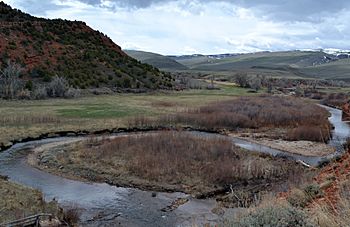Little Popo Agie River facts for kids
Quick facts for kids Little Popo Agie River |
|
|---|---|

The Little Popo Agie River near Red Canyon.
|
|

The course of the Little Popo Agie River
|
|
| Country | United States |
| State | Wyoming |
| Physical characteristics | |
| Main source | Christina Lake Wind River Range, Fremont County 10,000 ft (3,000 m) |
| River mouth | North Fork Popo Agie River Hudson, Wyoming 5,000 ft (1,500 m) 42°54′16″N 108°35′21″W / 42.9045°N 108.5893°W |
| Length | 58 mi (93 km), |
| Basin features | |
| Tributaries |
|
The Little Popo Agie River is a cool river in Fremont County, Wyoming. It starts way up high at Christina Lake in the Wind River Range. The river flows for about 58 miles (93 km) until it reaches its end near Hudson, Wyoming. It's one of three rivers named "Popo Agie," along with the Middle Fork and the North Fork Popo Agie River. The name "Popo Agie" comes from a Native American word meaning "Head River" or "Gurgling River."
The River's Journey
The Little Popo Agie River begins its journey high in the mountains. Its source, Christina Lake, is about 10,000 feet (3,048 meters) above sea level. That's really high up!
As the river flows, it travels downhill. By the time it reaches its end near Hudson, Wyoming, it's about 5,000 feet (1,524 meters) above sea level. That's a drop of about 5,000 feet from start to finish!
A Look at History
In the 1800s, the areas along the Little Popo Agie River saw some important historical events. There were times when the U.S. Army and Native American groups had conflicts in this region. These events are part of the river's long history.
River Health: Pollution Concerns
For a long time, some parts of the Little Popo Agie River have faced pollution problems. This pollution is believed to have come from oil operations nearby.
Around the early 1900s, reports said that a lot of oil waste was being dumped into the river. This caused problems for local people who used the river's water to help their farms grow crops. Later, in the 1950s, pollution from oil waste was connected to fewer fish living in the river. This shows how important it is to keep our rivers clean for everyone and for nature.


